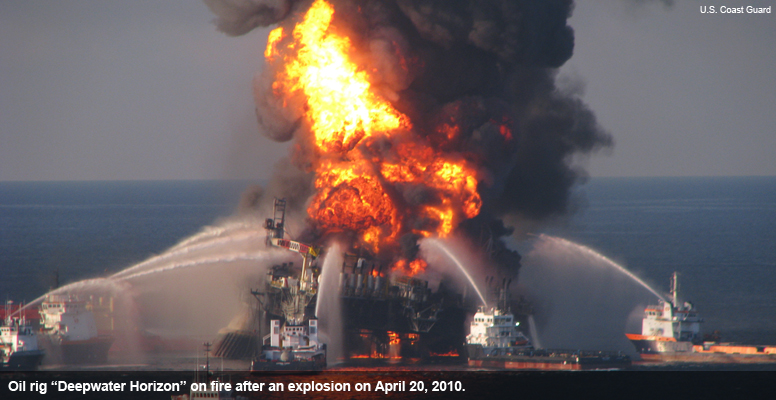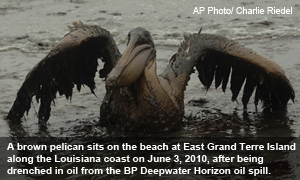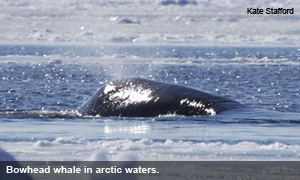The Deepwater Horizon Oil Spill: Four Years Later
On April 20, 2010, the BP Deepwater Horizon oil rig exploded, killing 11 people and setting into motion the largest oil spill in the nation's history.
In the 87 days it took to cap the well, almost 5 million barrels of oil spilled into the Gulf of Mexico, the equivalent of 19 Exxon Valdez oil spills. Scientists will spend years determining the costs to wildlife and fisheries, but this much is known:
- 1,843,786 gallons of chemical dispersant were dumped into the Gulf to try to break down the oil.
- An estimated 6,000 seabirds, 600 sea turtles, and an unknown number of bluefin and yellowfin tuna, dolphins, and other marine animals were killed.
- At the peak of the response, 47,000 people a day were involved in the cleanup along with 32 spill response vessels, six firefighting vessels, and dozens of airplanes and helicopters. Cleanup and restoration of the affected wildlife habitat took nearly four years to complete.
The disaster drew attention to the lax regulation of offshore energy exploration. Even though the number of U.S. offshore oil and gas leases had increased 200 percent from 1982 to 2007, the number of government inspectors did not keep pace. At the time of the spill, there was only one inspector for every 54 oil platforms in the Gulf.
After the spill, the House of Representatives passed a series of measures to help prevent similar disasters. Unfortunately, the Senate did not pass any of the 84 bills that were introduced to increase regulatory oversight.

The Obama administration took several steps to reform management of offshore energy in federal waters, and there is now a new focus on oversight. The regulatory agency overseeing offshore energy exploration, the Minerals Management Service, was reorganized into three separate agencies: a revenue collection unit, a management unit, and an environmental and safety compliance unit, each with an expanded budget to increase the number of inspectors.
The Department of the Interior also established new requirements for offshore energy in U.S. waters, including:
- Safety and Environmental Management Systems regulations to protect worker safety and prevent accidents.
- Drilling safety rules for such things as cementing and blowout preventers to seal off an oil well and prevent massive discharges like those seen in the Deepwater Horizon spill. These rules must receive an independent, third-party certification.
- Rules requiring rig operators to estimate the worst possible discharge from an explosion and to plan for blowouts, including determining how long it would take for a second rig to move to an accident and drill a relief well, and to promptly deploy surface and subsea containment units after a blowout.
- Elimination of categorical exclusions, which exempted some companies from an environmental assessment.
- Elimination of area wide oil and gas leasing, with a new focus on targeted leasing of smaller tracts in the Arctic outer continental shelf, allowing for more accurate environmental impact assessments.
 Although leasing and drilling slowed in U.S. waters after the Deepwater Horizon spill, there is now increased interest in drilling offshore in the riskier and more vulnerable frontier waters of the Arctic.
Although leasing and drilling slowed in U.S. waters after the Deepwater Horizon spill, there is now increased interest in drilling offshore in the riskier and more vulnerable frontier waters of the Arctic.
Those waters are ice-covered for eight or nine months of the year and are in almost complete darkness for nearly three of those months. Even during the summer, when the ice pack has mostly receded, the Arctic experiences high seas, wind, freezing temperatures, dense fog, and floating ice hazards.
Even more challenging, the major highways, airports, and ports that most Americans take for granted do not exist in the Arctic. The nearest Coast Guard base is more than 950 air miles away, and the closest large seaport is over 1,000 miles away, about the distance from Seattle to Los Angeles.
Technology for extraction of oil has far outpaced that for oil spill prevention and response. As we saw with the Deepwater Horizon spill, the response technology of skimmers, booms, dispersants, and burning has improved little in decades.
Pew has been strongly advocating for the United States to adopt specific Arctic standards to guide energy exploration, including:
- Seasonal drilling: Arctic offshore drilling operations in hydrocarbon-bearing zones should be limited to periods when rigs and their associated spill response systems are capable of working effectively in Arctic conditions. This restriction should include the time required for drilling a relief well to bring a blown-out well under control before winter ice moves in.
- Arctic-class equipment: Vessels, drilling rigs, and facilities should be built to withstand maximum ice forces and harsh ocean conditions.
- Local staging of well-control equipment: Equipment needed to control a well during a spill, such as relief rigs and containment systems, should be designed for and located in Alaska's Arctic so they can be deployed promptly.
- Local staging of spill response equipment: Equipment and adequately trained personnel should be staged in Alaska's Arctic and be capable of protecting sensitive shoreline and habitat in case of an oil spill.
- Drilling rig towing plan: The operator should demonstrate that it can safely transport the drilling rig in the most severe weather conditions that may be encountered, include at least one tug capable of towing the rig in worst-case conditions, and include contingencies for towing problems that may be encountered.
- Redundant systems: Backup blowout preventers, remotely operated controls, and other redundant systems should be installed, because harsh weather or ice cover can prevent access and use of most equipment for many months of the year.

The Pew Charitable Trusts does not oppose offshore drilling, but it believes there must be a balance between responsible energy development and protection of the environment. Traditional hunting and fishing areas must be exempted from future leasing to safeguard these areas for Alaska Natives, who have relied on these waters for centuries. And it is essential that appropriate standards be established for safety and for oil spill prevention and response in the Arctic.
“There should be world-leading standards for any company operating in the remote, extreme, and vulnerable Arctic Ocean. This would provide regulatory certainty for the industry and ensure protection of the marine ecosystem,” said Marilyn Heiman, who directs Pew's U.S. Arctic program. “It will also reduce the chance of another catastrophic event like the Deepwater Horizon spill.”






